|
Summary |
|||
|
One of the most distinctive features of striate cortex neurons is a
combined selectivity for stimulus orientation and the direction of
motion. Indeed, such neurons respond better to sinusoidal gratings that
are moving in one direction than to those that are moving in the opposite
one, and also exhibit a sharper velocity tuning with respect to
that of geniculate cells. Recent theoretical and neurophysiological
studies (DeAngelis et al. 1995; Reid et al. 1991; Hamilton et al. 1989)
pointed out that the origin of direction selectivity can be related to the
linear space-time receptive field structure of simple cells.
A large class of simple cells shows a very specific space-time behavior
in which the spatial phase of the receptive field changes gradually as a
function of time. This results in receptive field profiles that tilt along
an oblique axis in the space-time domain (i.e, they are space-time
inseparable).
The origin of such inseparability has been
related to a systematic space-dependent alteration in the temporal
response
characteristics of the geniculate inputs, presumably associated with
spatial and temporal
asymmetric cortical mechanisms. Most models, however, do not consider
explicit
recurrent asymmetric intracortical processes; rather, they rely upon
asymmetric convergence (in space and/or time) of feed-forward
contributions, possibly
mediated by cortical interneurons. Moreover, a clear distinction between
the roles of
purely spatial and purely temporal mechanisms has not yet been made.
To account for the origin of this spatiotemporal inseparability, we propose and analyze a linear architectural model for simple cell spatiotemporal receptive field formation, based on intracortical interactions occurring through asymmetric recurrent inhibition schemes. Spatial asymmetries are included explicitly as systematic variations in a basic interconnection pattern with a symmetrical structure. No explicit asymmetrical temporal mechanisms are introduced or adopted. The strong direction selectivity and the sharp velocity tuning curves, obtained without any feed-forward direction selectivity bias, support the idea that the spatial asymmetry of lateral (i.e., recurrent) inhibitory connections may be a primary mechanism of cortical direction tuning. |
|
||
|
Results We have pointed out that a purely spatial asymmetry is sufficient to generate directional selectivity, when spatially asymmetric contributions arise through recurrent intracortical inhibitory circuits. Therefore, the space-time orientation of the resulting receptive fields emerges as a dynamic property of our cortical network, thus leading to highly structured space-time receptive fields starting from space-time separable Gaussian subunits i.e., geniculate inputs). Our model can be characterized as a linear model of homogeneous layers with feedback. The linearity assumption, together with the model's essentiality, allows a detailed analysis of the basic mechanism of directionality in the Fourier domain. The spatial and temporal components of the resulting transfer function are, indeed, closely coupled considering that the spatial and temporal frequencies are no longer factorizable. The nature of this coupling strongly depends on the shape of the interaction kernel. Specifically, asymmetrical profiles of the inhibitory kernel give rise to complex forms in the denominator of the overall trasfer function, and hence to complex poles that result in spatiotemporal oscillatory behaviors. The presence of such poles is the determining factor of the generation mechanism of motion sensitivity. A systematic study of the effects of the geometrical parameters which characterize the inhibitory kernel reveals that the most effective parameter for the origin of direction selectivity is the distance from which inhibition arises along the stimulus motion axis. |
|||
| Spatial receptive field movie of a model direction selective cell | |||
| Effects of distance of inhibition on direction selectivity and velocity tuning curve | |||
